The Biomass Gasification Market is estimated to be valued at USD 124.2 billion in 2025 and is projected to reach USD 293.9 billion by 2035, registering a compound annual growth rate (CAGR) of 8.9% over the forecast period.
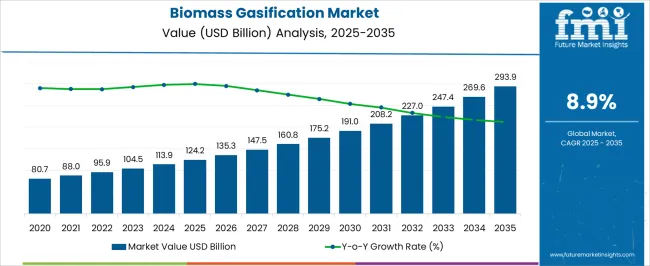
| Metric | Value |
|---|---|
| Biomass Gasification Market Estimated Value in (2025 E) | USD 124.2 billion |
| Biomass Gasification Market Forecast Value in (2035 F) | USD 293.9 billion |
| Forecast CAGR (2025 to 2035) | 8.9% |
The biomass gasification market is gaining momentum as global energy systems transition toward renewable and sustainable fuel sources. Energy policy frameworks and climate agreements have emphasized the reduction of carbon footprints, making biomass gasification a viable pathway for low-emission energy production.
Industry reports and energy utility announcements have highlighted growing adoption of gasification technologies due to their efficiency in converting biomass into syngas for power, heat, and chemical applications. The availability of diverse biomass feedstocks, including woody and agricultural residues, has supported flexible deployment across regions.
Additionally, advancements in gasifier design and process optimization have improved conversion efficiency and reduced tar-related challenges, enhancing reliability. Investments from governments and private entities in decentralized energy projects have further bolstered growth, especially in rural and industrial areas where waste-to-energy solutions address both environmental and energy security concerns. Looking forward, continued innovation in integrated gasification combined cycle (IGCC) systems, coupled with policy incentives, is expected to expand market adoption and unlock new opportunities in hydrogen production and clean fuel applications.
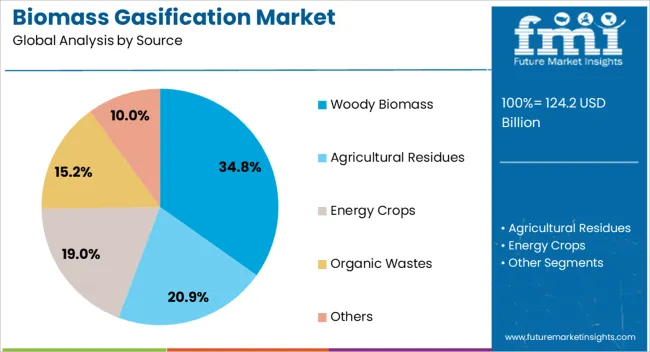
The Woody Biomass segment is projected to account for 34.8% of the biomass gasification market revenue in 2025, reflecting its status as the primary feedstock category. Growth has been driven by the high calorific value, consistent availability, and relatively low moisture content of woody biomass compared to agricultural residues.
Forestry by-products, sawmill waste, and energy crops have been extensively utilized, ensuring steady supply chains for gasification projects. Industry updates have emphasized the stability and uniformity of woody biomass, which contribute to higher conversion efficiencies and reduced operational variability.
Moreover, woody biomass has been favored in regions with well-developed forestry industries, where sustainability certifications and reforestation programs ensure long-term resource availability. This reliable feedstock base has solidified the dominance of the Woody Biomass segment in the global biomass gasification market.
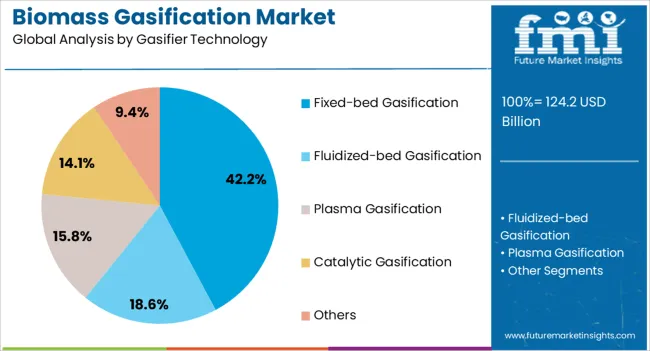
The Fixed-bed Gasification segment is projected to contribute 42.2% of the biomass gasification market revenue in 2025, positioning it as the leading technology. Its dominance has been attributed to the relatively simple design, lower investment costs, and operational suitability for small to medium-scale projects.
Energy project assessments have noted that fixed-bed gasifiers offer high fuel flexibility, making them ideal for rural electrification, district heating, and industrial applications. Additionally, the ability of fixed-bed systems to operate with minimal pre-treatment of biomass has reduced operational complexity and capital intensity.
Their proven reliability and widespread deployment across developing regions have reinforced their market leadership. As decentralized energy generation gains traction, fixed-bed gasification technology is expected to sustain its strong role in the market.
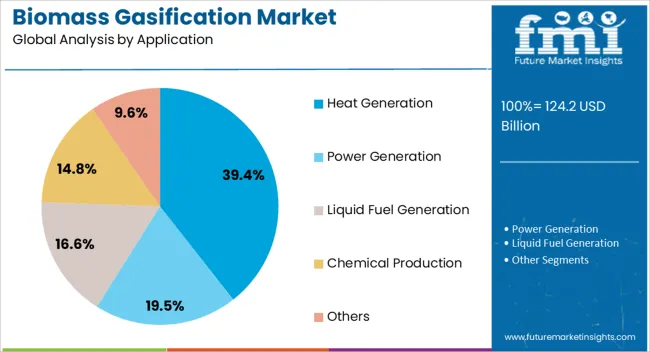
The Heat Generation segment is anticipated to account for 39.4% of the biomass gasification market revenue in 2025, maintaining its position as the leading application. This growth has been driven by the demand for renewable heating solutions in industrial processes, district heating networks, and rural energy systems.
Biomass gasification has been recognized for its efficiency in providing consistent thermal output, reducing dependence on fossil fuels for heat production. Industrial energy demand, particularly in manufacturing and processing sectors, has increasingly relied on syngas-based heat due to its cost efficiency and environmental benefits.
Policy incentives promoting renewable heat adoption, combined with carbon reduction commitments, have further strengthened this segment. With ongoing efforts to decarbonize heating in both developed and emerging economies, the Heat Generation segment is expected to remain the primary application of biomass gasification technologies.
Biogas demand is on the upward thrust as families look for options to traditional fossil fuels. This, in turn, is set to propel demand for gasification. It reflects growing recognition of the environmental effect of conventional power assets on the surroundings and the preference of owners for sustainable solutions.
Companies around the world are increasingly adopting gasification to satisfy their energy wishes sustainably. By using biomass for heating, energy, and biofuel production, companies intend to reduce their carbon footprint and comply with stringent environmental guidelines.
Biomass gasification is gaining a reputation in off-grid and far-off regions where utilizing conventional grid infrastructure is constrained or unreliable. Communities and companies in such areas are turning to gasification as a dependable and sustainable electricity answer.
Innovations in biomass gasification technology are set to create new growth prospects for the industry. Similarly, surging demand for syngas from diverse industries will play a key role in boosting the target industry.
Syngas are widely used as fuel in internal combustion engines or gas turbines to generate electricity. Similarly, it finds application for hydrogen production. These increasing applications of syngas are anticipated to positively impact industry growth.
Global demand for biomass gasification increased at a slow CAGR of 3.7% from 2020 to 2025. This growth was propelled by increased energy demand and transition towards renewable energy sources.
In the next ten years, the target industry is forecast to register a robust CAGR of 9%, indicating a serious spike of 5.3% CAGR from the historical growth rate. Increasing demand for renewable power throughout the globe is a prominent factor behind this high growth.
Gasification gives a sustainable alternative to fossil fuels, changing organic materials into smooth power resources like syngas and biofuels. As governments globally implement rules to encourage renewable power adoption, the gasification marketplace is positioned for sizable expansion in the years in advance.
Enhancing Biomass Gasification through Integrated Energy Systems
The integration of biomass gasification with different electricity structures, including combined heat and power (CHP), is positively impacting the industry. By combining the production of strength and heat in a single, integrated device, CHP maximizes the efficiency of electricity utilization.
CHP enhances the general economic viability and environmental sustainability of gasification projects. This integration allows for the simultaneous generation of energy and heat from biomass feedstocks, optimizing aid usage and minimizing waste.
CHP systems have the ability to satisfy varying power needs. This makes them well-appropriate for both centralized and decentralized power production scenarios. The capability to co-generate heat along power complements the elegance for district heating, industrial applications, and residential heating.
The synergy accomplished through the mixing of gasification with CHP systems amplifies its versatility and effectiveness. Growing popularity of these integrated systems will likely boost industry growth.
Surging Adoption of Gasification in the Global Clean Energy Landscape
The growing international recognition and firm commitments to acquire carbon neutrality, each among nations and organizations, are propelling the extensive adoption of gasification. This technology is gaining prominence due to its class as carbon-impartial or low-carbon, mainly when utilizing sustainably sourced biomass feedstock.
Countries and organizations are under mounting pressure to reduce their carbon footprints and transition closer to cleaner, more sustainable electricity assets. Gasification offers a compelling answer, as it allows the conversion of natural substances into power at the same time as minimizing internet carbon emissions.
Biomass gasification aligns with global weather goals, which include the ones mentioned within the Paris Agreement. This technology can reduce greenhouse emissions and help to attain a circular economic system.
Diversified Biomass Feedstock for Gasification
The research efforts are directed closer to the development of novel biomass feedstock resources, ranging from algae to energy vegetation and agricultural residues. This assorted technique to feedstock choice holds the ability to beautify the resilience and sustainability of biomass gasification projects noticeably.
Algae, for example, are becoming promising candidates for biomass feedstock. Similarly, agricultural residues, which include crop residues, represent plentiful and effortlessly available biomass resources that can be efficiently applied for gasification.
The exploration of latest feedstock resources contributes to the general sustainability of gasification. It additionally fosters the improvement of greater green and environmentally pleasant biomass-to-energy conversion procedures.
Despite a robust growth trajectory, there are certain factors that might limit biomass gasification market growth. These include:
Technical Challenges
Biomass gasification methods present numerous technical demanding situations that may limit their adoption and effectiveness. Firstly, ensuring high gasifier efficiency is crucial for maximizing electricity output and economic viability.
Variability in feedstock composition provides complexity, as exceptional biomass types require tailored gasification conditions, impacting system balance and gasoline satisfaction. Moreover, machine reliability is paramount to ensure non-stop operation and minimize downtime, necessitating sturdy layout and maintenance practices.
The technical restraints highlight the need for ongoing research and development efforts within the gasification sector. By addressing those demanding situations, advances can be made in gasifier design, feedstock handling technology, and machine integration, ultimately enhancing the efficiency, reliability, and scalability of gasification methods.
Tough Competition from Other Renewable Energy Sources
In the dynamic panorama of renewable energy, gasification competes with established technologies like solar and wind strength. The marketplace proportion of gasification hinges on several key elements, such as value competitiveness and intermittency relative to its alternatives.
Gasification boasts advantages such as baseload energy technology and grid stability, distinguishing it from solar and wind electricity. However, its competitiveness can be undermined by fluctuations in the costs of solar and wind power manufacturing.
To navigate these aggressive dynamics effectively, it is important to strive for stability among the precise attributes of gasification and the strengths of other renewable electricity technologies. This involves ongoing efforts to enhance performance, lessen expenses, and address intermittency problems related to gasification.
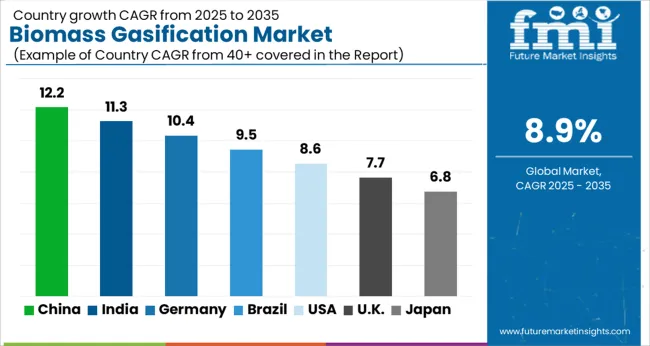
The table below highlights the market outlook for biomass gasification applications across various sectors in different nations. China, the United States, & India are set to remain top three pockets, with expected valuations of USD 293.9 billion, USD 26.3 billion, and USD 21.1 billion, respectively, in 2035.
The below table shows the estimated growth rates of the top countries. Other African Union, ANZ, and other GCC are set to record high CAGRs of 11.8%, 11.6%, and 11.4%, respectively, through 2035.
China is poised to register strong growth, with total industry valuation reaching USD 293.9 billion by 2035. Several factors are fueling growth of the country, and the trend is set to persist through 2035.
China's large population and rapid industrialization have resulted in rising energy consumption, pushing the government to seek sustainable alternatives to fossil fuels. Gasification is a viable alternative that aligns with the country’s aim to reduce carbon emissions and combat air pollution.
The country has rich biomass resources, such as agricultural wastes, forestry waste, and organic municipal solid waste. The availability of such feedstock establishes a good platform for biomass gasification operations in a variety of industries, including electricity generating, heating, and biofuel manufacturing.
China’s emphasis on renewable energy policies and incentives has increased investment in biomass gasification technologies and infrastructure development. The government's support in the form of subsidies, tax breaks, and favorable regulatory frameworks encourages both domestic and foreign investors to enter the market.
The country’s considerable research and development efforts in gasification technology have resulted in improvements in efficiency, scalability, and cost-effectiveness. Collaborations between academics, research institutes, and industry players help to drive innovation and ongoing development in gasification processes.
The United States market is set to witness healthy growth due to several key factors. Firstly, the nation possesses abundant biomass resources, including agricultural residues, forestry waste, and dedicated energy crops, providing a robust foundation for biomass gasification projects. This rich resource base ensures a steady and sustainable supply of feedstock for gasification processes.
The United States has a strong tradition of innovation and technological advances in the energy sector. With extensive research and development initiatives, the nation has made significant strides in biomass gasification technology, resulting in improved efficiency, scalability, and cost-effectiveness of gasification processes.
The nation’s government has implemented supportive policies and incentives to promote renewable energy development. These policies include tax credits, grants, loan guarantees, and renewable energy standards, which encourage investment in gasification projects and foster growth.
The United States boasts a diverse energy landscape and a well-developed infrastructure, facilitating the integration of biomass gasification into existing energy systems. This adaptability allows for the utilization of syngas and biofuels produced through gasification in various applications, including power generation, heating, and transportation.
Growing environmental concerns and the need to reduce greenhouse gas emissions further propel demand for renewable energy sources like biomass gasification. With its favorable regulatory environment, technological expertise, and abundant biomass resources, the United States is set to offer lucrative opportunities to industry players.
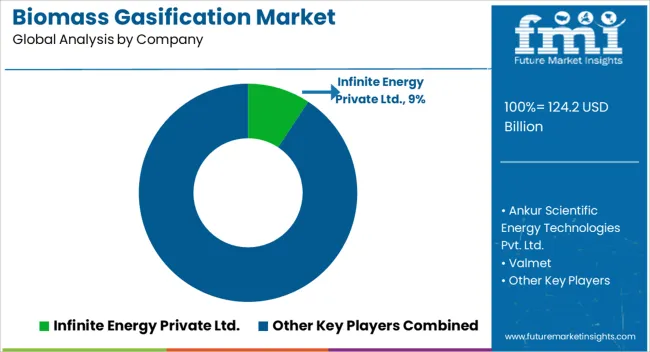
The section below throws some light on top segments along with their estimated growth rates. This information can be essential for companies to assess different segments and their impact on the industry growth.
Based on source, the woody biomass segment is set to retain its dominance, accounting for a volume share of 34.8% in 2025. This can be attributed to its consistent supply and environmental benefits.
The fixed-bed gasification segment is anticipated to lead the industry, holding a volume share of 42.2% in 2025. This is due to multiple advantages of this gasification technology, including versatility and simpler design.
| Top Segment | Woody Biomass (Source) |
|---|---|
| Market Share (2025) | 34.8% |
The woody biomass segment is anticipated to dominate the market, holding a significant volume share of 34.8% in 2025. It is set to account for a value of USD 93.1 billion at the end of the forecast period.
Growing preference for woody biomass as a feedstock source is providing impetus for segment growth. Factors such as abundant availability, renewable nature, and favorable energy conversion properties contribute to its dominance.
Industries and governments worldwide prioritize sustainable energy solutions. This, in turn, is set to encourage adoption of woody biomass in gasification process. Usage of this feedstock will also help countries to meet renewable energy targets.
| Top Segment | Fixed-bed Gasification (Gasifier Technology) |
|---|---|
| Market Share (2025) | 42.2% |
Fixed-bed gasification remains a popular technology globally due to its multiple advantages. The target segment is set to account for a significant volume share of 42.2% in 2025.
Fixed-bed gasification has become a versatile technology for converting biomass or fossil fuels into syngas. Its benefits, such as simple design, low capital cost, high thermal efficiency, and ability to handle a variety of feedstock, will contribute to its adoption through 2035.
The global industry is fragmented, with leading players accounting for about 10% to 15% share. Key players are focusing on introducing new innovative technologies with improved conversion efficiencies. They also employ strategies like distribution agreements, partnerships, acquisitions, and new facility establishments to stay ahead.
Recent Developments
| Date and Approach | Description |
|---|---|
| May 2025, New Facility Opening | Finland-based Valmet inaugurated its new Biotrac pre-treatment pilot plant at the fiber technology center in Sundsvall, Sweden. The pilot facility investment would allow Valmet to improve its research and development capabilities in the field of biomass pre-treatment, as well as respond to market demand for bioenergy, biofuels, and biochemicals. |
| November 2025, New Facility Establishment | Klabin started a new biomass gasification plant in Brazil with Austria-based ANDRITZ’s biomass treatment line. |
Based on source the global industry is segmented into woody biomass, agricultural residues, energy crops, organic wastes, and others.
In terms of gasifier technology, the report is categorized into fixed-bed gasification, fluidized-bed gasification, plasma gasification, catalytic gasification, and others.
By applications, the industry is segmented into power generation, heat generation, liquid fuel generation, chemical production, and others.
Analysis of the target industry has been carried out in key countries of North America, Latin America, East Asia, South Asia & Pacific, Western Europe, Eastern Europe, and the Middle East & Africa.
The global biomass gasification market is estimated to be valued at USD 124.2 billion in 2025.
The market size for the biomass gasification market is projected to reach USD 293.9 billion by 2035.
The biomass gasification market is expected to grow at a 8.9% CAGR between 2025 and 2035.
The key product types in biomass gasification market are woody biomass, agricultural residues, energy crops, organic wastes and others.
In terms of gasifier technology, fixed-bed gasification segment to command 42.2% share in the biomass gasification market in 2025.






Full Research Suite comprises of:
Market outlook & trends analysis
Interviews & case studies
Strategic recommendations
Vendor profiles & capabilities analysis
5-year forecasts
8 regions and 60+ country-level data splits
Market segment data splits
12 months of continuous data updates
DELIVERED AS:
PDF EXCEL ONLINE
Biomass Hot Air Generator Furnace Market Size and Share Forecast Outlook 2025 to 2035
Biomass Pellets Market Size and Share Forecast Outlook 2025 to 2035
Biomass Boiler Market Size and Share Forecast Outlook 2025 to 2035
Woody Biomass Boiler Market Size and Share Forecast Outlook 2025 to 2035
Europe Biomass Pellets Market Analysis & Forecast for 2025 to 2035
Demand for Biomass Pellets in EU Size and Share Forecast Outlook 2025 to 2035
Lignocellulosic Biomass Market Analysis - Size, Share, and Forecast Outlook for 2025 to 2035
Coal Gasification Liquid Hydrogen Market Size and Share Forecast Outlook 2025 to 2035
Underground Coal Gasification Industry Analysis in Asia Pacific Size and Share Forecast Outlook 2025 to 2035

Thank you!
You will receive an email from our Business Development Manager. Please be sure to check your SPAM/JUNK folder too.
Chat With
MaRIA